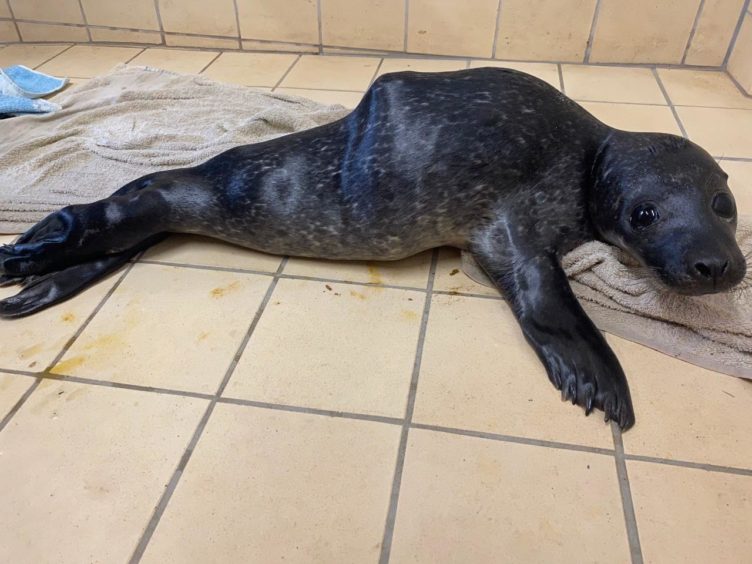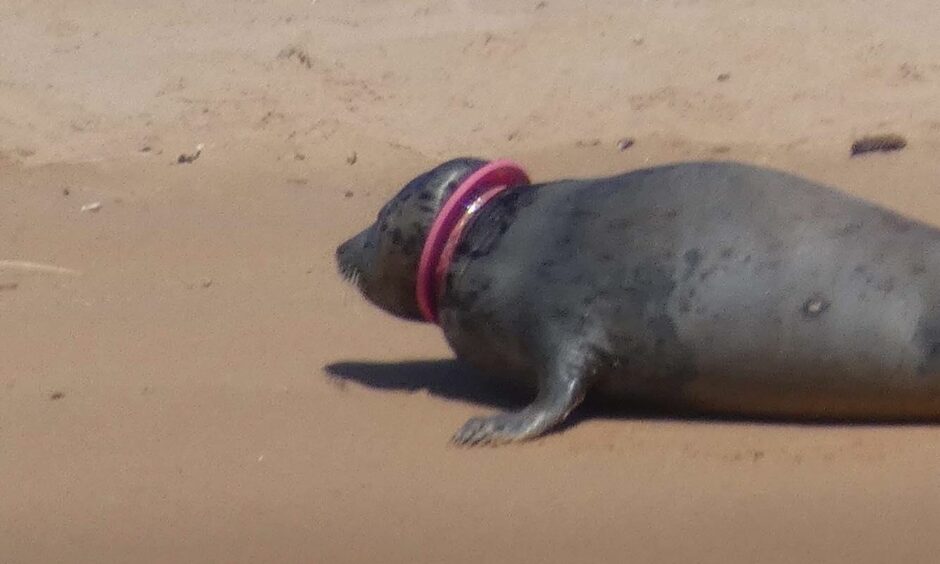Rescuers have described how they carried an injured seal pup from an inaccessible beach to give him a “second chance”.
Holidaymakers contacted Hillswick Wildlife Sanctuary after spotting the young seal in trouble on a remote beach on Unst.
Pete and Jan Bevington, who run the sanctuary in Shetland, realised from a photo that the pup – now called Sylvester – was too thin and had an ulcer in its eye.
They scrambled a group of locals together, who scaled a 15ft cliff by rope to get to the pup and then hoisted him back up to safety.
Mr Bevington explained: “Fortunately, we’ve got people in most parts of the island which we can call on to help if necessary, and we also work closely with the Scottish SPCA so they sometimes help as well.
“In this case, because it was a difficult to access beach, we contacted local people who knew the beach and were able to organise themselves. A group of them were able to support each other down and get the seal back up a cliff.”
Sylvester, is now at the Hillswick Wildlife Sanctuary after the successful rescue attempt and two ferry trips, but the couple are not hopeful he will survive.
They believe his rear end is paralysed, and if this is the case he will need to be put down.
‘Great rescue effort’
Mr Bevington said the pup was clearly in “considerable pain” but they were trying to build its strength by giving him fluids and some fish.
“Its not been able to feed at all for a long time, it’s as thin as a rake at the moment,” he said. “We’re managing to get fluid down it and get a little bit of fish in it to see if that livens it up, but we’re not optimistic I am afraid.
“It was a great rescue effort, and it’s just very sad this is the outcome of it all after such effort was put in.”
Sula Brookes was one of the members of the rescue group who set out to bring Sylvester to the sanctuary.
The 20-year-old said her dad Robbie Waddington is one of the sanctuary’s “go-to people” alongside his friend Brydon Thomason who runs nature tours of otters and seals, however, they were both off the island when her mum Catriona got the call.
The duo, along with Mr Thomason’s wife Vaila and their children, used a rope to get down the 12-15ft cliff to get to the beach.
Miss Brookes said: “He was too timid, I was expecting him to put up a bit more of a fight, so I put a sheet over his head to calm him down and stop him biting – they’ve got a serious set of teeth on them.
“But, he wasn’t moving that much, especially not his back, like his tail. Once I had him and Vaila had her hand on his head he was more subdued than I was expecting.
‘Seriously skinny’
“I had heard there was something up with his eye, but the main thing that surprised me was how small he was and skinny, like seriously skinny. It’s not nice to see.”
Once they had managed to hoist the emaciated pup back up the cliff, the group then had to take two ferries to get him to the Hillswick Wildlife Sanctuary.
Miss Brookes added: “Although he’s not looking great, to be honest I think it’s unlikely he will survive, at least this way he has been given a second chance and at least he can be put down in a humane way.
“It’s a nicer way to go, he would have just starved on the beach or the birds would have had him. They’re looking after him at the sanctuary and he’s definitely eating.”
The sanctuary, which has been running since 1987, currently has three other pups who are all doing well and are expected to be released back into the wild next month.
Often the pups have been abandoned by an inexperienced mother, or orphaned by an orca.
Mr Bevington added: “The other time we get them is when the pups have left their mum, or mum has left them and they’re trying to cope on their own and they get into trouble of some sort. It looks like this is the case with Sylvester.
“It looks like he’s had some kind of injury early on in his life, and obviously has got amazing spirit to have managed to survive for as long as he has.”
Sea pollution and seals
According to Mr Bevington the sanctuary is rescuing common seals that are smaller, weaker and harder to keep alive.
He said: “We are beginning to think they’re not learning to eat independently as quickly as they used to either, there seems to be a problem out there in the environment for the seals and no doubt for other sea creatures as well, which we think is caused by pollution that’s making it a tough environment to survive in.”
Mr Bevington described a “massive problem” with plastics and pollutants in the waters, which then accumulates in the food chain. Orcas are at the top of the food chain, but otherwise seals are quite high up and these toxins accumulate in their bodies.
Read more: Seal pup dies after mother’s two years of ‘agony’ from plastic around her neck
The only time a seal can decrease the amount of toxins in their system is for the mother seal, it goes into their milk and they unload it onto their pup.
“Thanks to the likes of David Attenborough, people are waking up more and more to the issues about wildlife, but there’s a lot more waking up that needs to be done.” He added.
“The plastic is a nightmare, it biodegrades and gets smaller and smaller, they say we all have plastic inside us these days, and it’s a disturbing thought. Humanity really does need to wake up and change its ways, and find ways to live in harmony with the nature and the environment because without it we wouldn’t be here.”

